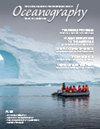Climate Roles of Non-Sea Salt Sulfate and Sea Spray Aerosol in the Atmospheric Marine Boundary Layer: Highlights of 40 Years of PMEL Research
IF 2.8
4区 地球科学
Q1 OCEANOGRAPHY
引用次数: 0
Abstract
The Pacific Marine Environmental Laboratory (PMEL) began measurements of dimethylsulfide (DMS) in 1982 to better understand the seawater sulfur cycle and the contribution of seawater DMS emissions to the global atmospheric sulfur budget. These measurements led to a global ocean database of DMS seawater concentrations currently hosted at PMEL, with contributions from researchers worldwide. In the mid-1980s, PMEL followed DMS from the ocean into the atmosphere and began aerosol measurements. It was found that DMS-derived, biogenic sulfate can make up a large fraction of the submicron aerosol in the remote marine atmosphere. In addition, it was found that a significant and variable fraction of submicron aerosol over the ocean was composed not only of biogenic sulfate but also included sea spray aerosol and long-range transported components. These measurements were pioneering in providing evidence that marine aerosols are a complex mixture of chemical components that should be included in climate models in order to accurately model Earth’s radiation budget. Measurements from 27 cruises have helped form a coherent view of species responsible for aerosol light scattering and cloud drop nucleation in the marine boundary layer. This global database of aerosol properties is publicly available on PMEL web pages for use by the modeling and satellite communities. Most recently, PMEL has developed payloads for uncrewed aerial systems to extend surface shipboard measurements up to 3,000 m in altitude and to include measurements of cloud properties.非海盐硫酸盐和海雾气溶胶在大气海洋边界层中的气候作用:40年PMEL研究的亮点
太平洋海洋环境实验室(PMEL)于1982年开始测量二甲硫(DMS),以更好地了解海水硫循环和海水DMS排放对全球大气硫预算的贡献。这些测量结果导致了PMEL目前托管的DMS海水浓度的全球海洋数据库,并得到了世界各地研究人员的贡献。在20世纪80年代中期,PMEL跟随DMS从海洋进入大气,并开始气溶胶测量。研究发现,dms衍生的生物源硫酸盐可以构成遥远海洋大气中亚微米气溶胶的很大一部分。此外,还发现海洋上空的亚微米气溶胶中有很大一部分是由生物硫酸盐组成的,而且还包括海洋喷雾气溶胶和远程运输成分。这些测量开创性地提供了证据,证明海洋气溶胶是化学成分的复杂混合物,应该包括在气候模型中,以便准确地模拟地球的辐射收支。来自27次巡航的测量结果帮助形成了对气溶胶光散射和海洋边界层中云滴成核的物种的一致看法。这个气溶胶特性的全球数据库在PMEL网页上公开提供,供建模和卫星社区使用。最近,PMEL为无人驾驶航空系统开发了有效载荷,将水面船载测量扩展到3000米的高度,并包括云特性的测量。
本文章由计算机程序翻译,如有差异,请以英文原文为准。
求助全文
约1分钟内获得全文
求助全文
来源期刊

Oceanography
地学-海洋学
CiteScore
6.10
自引率
3.60%
发文量
39
审稿时长
6-12 weeks
期刊介绍:
First published in July 1988, Oceanography is the official magazine of The Oceanography Society. It contains peer-reviewed articles that chronicle all aspects of ocean science and its applications. In addition, Oceanography solicits and publishes news and information, meeting reports, hands-on laboratory exercises, career profiles, book reviews, and shorter, editor-reviewed articles that address public policy and education and how they are affected by science and technology. We encourage submission of short papers to the Breaking Waves section that describe novel approaches to multidisciplinary problems in ocean science.
 求助内容:
求助内容: 应助结果提醒方式:
应助结果提醒方式:


